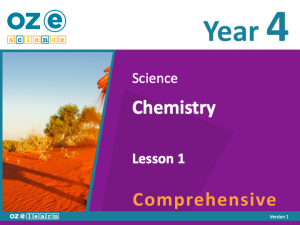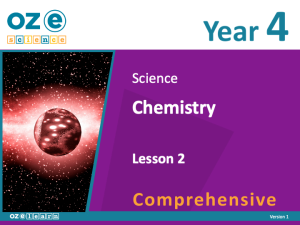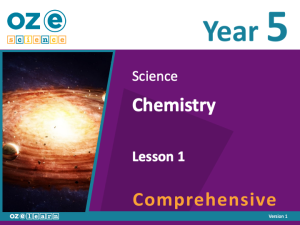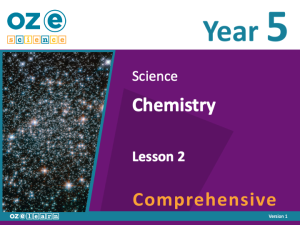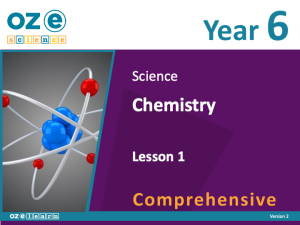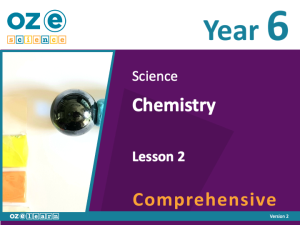Oz-e-science
Chemistry Comprehensive Years 4–6
Oz-e-Science Chemistry Comprehensive Year units align to the Australian Curriculum Content Descriptions
Free Starter Lessons
Year Overview
Year 4
Australian Curriculum Content Descriptions
Overview
Chemistry Comprehensive Year 4 is a Chemical Sciences curriculum program for Year 4 students. It aligns to the Australian Curriculum Science Understanding.
- ‘Natural and processed materials have a range of physical properties that can influence their use (ACSSU074).
Note: This curriculum program is currently being updated to align with the Australian Curriculum 9.0. Updated versions will be released in early 2024.
Learning Objectives
In Lessons 1 to 15, students learn about:
- how the universe is made up of very small particles called atoms
- the first two and most common elements in the universe – hydrogen and helium
- the role of hydrogen in the formation of the early universe and its importance to life on Earth
- some of the first 18 elements of the periodic table
- the story of Mendeleev and the development of the periodic table
- the physical properties of elements
- the main elements that make up the human body
- the elements that are present in healthcare products, and their benefits
- the steps in the Scientific Method
- conducting part one of the experiment by following the Scientific Method
- conducting part two of the experiment by following the Scientific Method
- evaluating and explaining the results of the experiment
- reporting and communicating our results of the experiment to an audience.
Success Criteria
- Describe at least four common molecules.
- Describe three ways in which elements are formed in the universe.
- Identify and sort elements according to when they first formed in the universe.
- Compare the size of different stars.
- Describe how elements are formed by massive stars.
- Explain how elements are formed in the supernova.
- Identify elements in the periodic table that are metals, metalloids and non-metals.
- Predict elements from their properties.
Describe the formation of molecules in solid, liquid and gas. - Explain the process that occurs to molecules during the change of state.
- Identify the properties of solid elements.
- Identify the properties of common solid compounds.
- Compare the properties of solid compounds.
- Describe the properties of liquid.
- Compare the properties of different liquids.
- Explain how the unique properties of water make it essential for life on Earth.
- Describe the properties of gas.
- Investigate how different materials grow different crystals.
- Plan how to grow crystals at home.
- Predict and hypothesise which crystals will grow best at home.
Assessment
Progress Tests
Progress Tests are conducted after every second lesson, allowing teachers to monitor student understanding of the concepts taught over the past two lessons and to identify where reteaching is needed. The Teaching Guide contains the testing questions, and the Student Workbook has a section where students write their answers and score themselves.
Structured Research Activity
The Structured Research Activity (SRA) for this unit is: Students plan, conduct and report on an experiment to test the effectiveness of toothpaste at removing stains. The SRA takes place over two lessons so students can apply the Science Understanding and Science Inquiry Skills covered in the unit. Teachers use the Guide to Making Judgements, which is included in the Teaching Guide, to mark the SRA.
End-of-Unit Assessment
The last lesson is the End-of-Unit Assessment, which has a variety of question formats (e.g. label the diagram, circle the correct answer) to assess student mastery of content from the unit. The End-of-Unit Assessment is in the Teaching Guide. Teachers copy the assessment and distribute to students at testing time.
Explicit Instruction for Science
Oz-e-science uses a teaching approach and curriculum that uses explicit teaching of content knowledge of science and explicit teaching and practical scientific inquiry using the Scientific Method. Read more about pedagogy here.
Year 5
Australian Curriculum Content Descriptions
Overview
Chemistry Comprehensive Year 5 is a Chemical Sciences curriculum program for Year 5 students. It aligns to the Australian Curriculum Science Understanding:
- Solids, liquids and gases have different observable properties and behave in different ways (ACSSU007).
Note: This curriculum program is currently being updated to align with the Australian Curriculum 9.0. Updated versions will be released in early 2024.
Learning Objectives
In Lessons 1 to 15, students learn about:
- how everything in the universe is made up of very small particles called atoms
- the first two and most common elements in the universe – hydrogen and helium
- the role of hydrogen in the formation of the early universe and its importance to life on Earth
- some of the first 18 elements of the periodic table
- the story of Mendeleev and the development of the periodic table
- the physical properties of elements
- the main elements that make up the human body
- the elements that are present in healthcare products, and their benefits
- the steps in the Scientific Method and conduct part one of an experiment by following the scientific method, and conduct part two of the experiment by following the scientific method
- evaluating and explaining the results of the experiment
- how to report and communicate the results of the experiment to an audience.
Success Criteria
- Explain the formation of hydrogen and helium.
- Label the parts of a hydrogen and helium atom.
- Identify the first two elements created.
- Represent the first two elements by making a model of their atoms.
- Identify the role of hydrogen in the formation of the early universe and life on Earth.
- Represent on a timeline the formation of the first two elements – hydrogen and helium.
- Identify some of the first 18 elements in the periodic table.
- Represent the elements on some playing cards.
- Describe the story of Mendeleev and the periodic table.
- Represent the story of the development of the periodic table on a timeline.
- Represent the elements studied so far on a periodic table desk mat.
- Identify the physical properties of elements.
- Record the physical properties of elements.
- Make a model of the molecular structure of a diamond.
- Identify the main elements in the human body.
- Represent the main elements in an outline of the human body.
- Record the elements in healthcare products.
- Analyse the benefits of the elements in the healthcare products.
- Identify the steps in the Scientific Method.
- Sequence the steps in the Scientific Method.
- Ask a scientific question.
- Develop a hypothesis and make a prediction.
- Conduct the experiment and make observations.
- Conduct part two of the experiment and record observations.
- Evaluate the results of the experiment using the observations.
- Explain the results using the observations.
- Report and communicate the results of the experiment using the observations and evaluation.
Assessment
Progress Tests
Progress Tests are conducted after every second lesson, allowing teachers to monitor student understanding of the concepts taught over the past two lessons and to identify where reteaching is needed. The Teaching Guide contains the testing questions, and the Student Workbook has a section where students write their answers and score themselves.
Structured Research Activity
The Structured Research Activity (SRA) for this unit is students plan, conduct and report on an experiment to describe how the observable properties of crystals behave and grow in different way. The SRA takes place over two lessons so students can apply the Science Understanding and Science Inquiry Skills covered in the unit. Teachers use the Guide to Making Judgements, which is included in the Teaching Guide, to mark the SRA
End-of-Unit Assessment
The last lesson is the end-of-unit assessment, which has a variety of question formats (e.g. label the diagram, circle the correct answer) to assess student mastery of content from the unit. The end-of-unit assessment is in the Teaching Guide. Teachers copy the assessment and distribute to students at testing time.
Explicit Instruction for Science
Oz-e-science uses a teaching approach and curriculum that uses explicit teaching of content knowledge of science and explicit teaching and practical scientific inquiry using the Scientific Method. Read more about pedagogy here.
Year 6
Australian Curriculum Content Descriptions
Overview
Chemistry Comprehensive Year 6 is a Chemical Sciences curriculum program for Year 6 students. It aligns to the Australian Curriculum Science Understanding:
- Changes to materials can be reversible or irreversible (ACSSU0950).
Note: This curriculum program is currently being updated to align with the Australian Curriculum 9.0. Updated versions will be released in early 2024.
Learning Objectives
In Lessons 1 to 15, students learn about:
- the smallest particles called atoms and what they are made of
- molecules
- how iron was formed
- electrons
- how some atoms share electrons and bond together
- some atoms that are highly reactive and others that are happy as they are
- how objects and chemical elements can be sorted by their physical properties
- how elements are sorted into the Periodic Table of Elements by their properties
- the physical changes of materials
- how physical changes can be used in recycling materials
- the chemical changes of materials
- how chemical changes can be used in recycling materials
- how to conduct an experiment using the scientific method
- conducting the rusting iron experiment
- how to present the findings of the rusting experiment.
Success Criteria
- Explain that all matter is made up of atoms.
- Describe the structure of an atom.
- Represent the structure of an atom.
- Explain what molecules and compounds are.
- Compare simple molecules with compound molecules.
- Represent the structure of a compound molecule.
- Explain how iron was formed.
- Represent the galactic story of iron.
- Explain what electrons are.
- Describe where electrons can be found in different elements.
- Represent the number of electrons in an electron game.
- Explain how atoms can give or take electrons from other atoms.
- Describe how giving and taking electrons leads to atoms bonding.
- Represent how atoms bond in the electron bonding game.
- Explain why some atoms are more reactive than others.
- Sort atoms by their reactivity.
- Describe how objects can be sorted into tables by their properties.
- Describe how elements are sorted into the Periodic Table of Elements.
- Sort elements into the Periodic Table by their properties.
- Predict where elements might be placed in the Periodic Table.
- Explain what happens when a material is physically changed.
- Describe what happens to the molecules when physical change occurs.
- Predict what happens when slime is physically changed.
- Explain what happens when a material is physically recycled.
- Describe which materials can be physically recycled.
- Sequence the steps of physically recycling materials.
- Explain what happens when a material chemically changes.
- Describe what happens to the molecules when chemical change occurs.
- Predict what happens in an everyday chemical reaction.
- Explain what happens when a material is chemically recycled.
- Describe which materials can be chemically recycled.
- Sequence the steps of chemically recycling materials.
- Ask a question, develop a hypothesis, predict an outcome for an experiment and observe to understand which liquids can make iron rust.
- Observe, evaluate and explain the experiment to understand which liquids can make iron rust.
- Report findings from investigation and communicate them to an audience.
Assessment
Progress Tests
Progress tests are conducted after every second lesson, allowing teachers to monitor student understanding of the concepts taught over the past two lessons and to identify where reteaching is needed. The Teaching Guide contains the testing questions, and the Student Workbook has a section where students write their answers and score themselves.
Structured Research Activity
The Structured Research Activity (SRA) for this unit is: Students plan, conduct and report on an experiment to test the which liquids cause iron to rust. The SRA takes place over two lessons so students can apply the Science Understanding and Science Inquiry Skills covered in the unit. Teachers use the Guide to Making Judgements, which is included in the Teaching Guide, to mark the SRA.
End-of-Unit Assessment
The last lesson is the end-of-unit assessment, which has a variety of question formats (e.g., label the diagram, circle the correct answer) to assess student mastery of content from the unit. The end-of-unit assessment is in the Teaching Guide. Teachers copy the assessment and distribute to students at testing time.
Explicit Instruction for Science
Oz-e-science uses a teaching approach and curriculum that uses explicit teaching of content knowledge of science and explicit teaching and practical scientific inquiry using the Scientific Method. Read more about pedagogy here.
Other Units
Lesson Design
Lesson Objective
Success Criteria
Activating Prior Knowledge
I Do
We Do
Apple Question
You Do
Revise
Professional Learning


